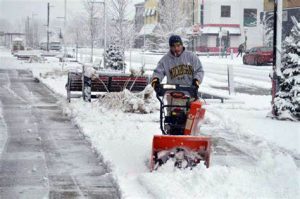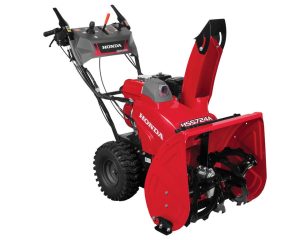6 Reasons a Craftsman Snowblower Starts Then Dies (This is Why!)
The worse time your Craftsman snowblower can stop running is in the middle of a snowstorm. So when it does, it’s important to get your snowblower up and running again so you don’t have to rely on a snow shovel.
A Craftsman snowblower starts and then dies when old fuel causes fuel restrictions in the fuel system. This can cause a dirty carburetor, clogged fuel line, plugged fuel filter, or bad fuel cap. A dirty spark plug can also cause a Craftsman snowblower to stop running.
Before performing any repairs, make sure you follow all safety precautions outlined in your operator’s manual. This includes shutting off the snowblower and removing the spark plug wire.

This post may include affiliate links. Purchases made through these links may provide a commission for us, at no extra cost to you. As an Amazon Associate, we earn from qualifying purchases.
Follow all safety instructions provided in your equipment operator’s manual prior to diagnosing, repairing, or operating.Consult a professional if you don’t have the skills, or knowledge or are not in the condition to perform the repair safely.
Table of Contents
6 Reasons Your Craftsman Snowblower Stops Running
1. Bad Fuel in Your Craftsman Snowblower
Old or bad fuel is a big culprit when it comes to fuel restrictions that cause a snowblower to die after it’s been running.
Gasoline used in your snowblower can begin to break down and lose some of its combustible properties as soon as 30 days after purchase.
Most types of gasoline include ethanol, an alternative fuel added to make gas a little environmentally friendly. Fuels containing ethanol collect moisture from the air.
The water and ethanol mixture can evaporate leaving a residue that clogs the fuel system. If you find the fuel in your tank is old, drain it using a fuel siphon pump and add fresh fuel.
It’s also a good idea to add a fuel additive like Sea Foam Motor Treatment or STA-BIL to help reduce moisture and clean the fuel system. These fuel additives will keep your fuel stable as well.
Determine what type of engine you have on your Craftsman snowblower. 2-cycle and 4-cycle snowblowers require different types of fuel. Adding the wrong type of fuel can damage the engine.
2-cycle (2-stage) Craftsman snowblowers require unleaded gasoline with an ethanol content of 10% or less mixed with 2-cycle engine oil.
If you are unsure what type of engine you are running through your snowblower, check your operator’s manual.
4-cycle (4-stage) Craftsman snowblowers require unleaded gasoline with an ethanol content of 10% or less.
The correct gas-to-oil mix ratio can be found in your operator’s manual. You may also find it listed on your fuel cap. A 2-cycle engine will have one fill port for a gas and oil mixture.
A 4-cycle engine will have two separate fill ports: one for gas and one for oil.
Read more about choosing the best type of fuel for your snowblower in “This is the Gas to Use in a Craftsman Snowblowers“.
2. Craftsman Snowblower Carburetor is Dirty
A dirty snowblower carburetor can cause your snowblower to stop running. The carburetor is designed to regulate the amount of air with the right amount of fuel to create a combustion.
You will need to check and clean your carburetor if necessary. This may sound complicated, but it really is not. If you are not very mechanically inclined, you should bring your snowblower to a repair center.
If you are mechanically inclined, then read on. If your carburetor is in a condition that is beyond cleaning, you will need to replace it.
12 Steps to Identify and Clean Your Dirty Craftsman Carburetor
- Spray carb cleaner to minimize carbon buildup. Spray some carb cleaner in the air intake. Start the engine to see if it will run. If the snowblower fires up and still won’t stay running, then we need to get inside the carburetor.
- Gather pliers, screwdrivers, sockets, and ratchets so you don’t destroy parts while taking the carburetor apart.
- Take a photo for reassembly. These days most people have a handy camera on their phones. It’s a very good idea to take a picture of the carburetor so you can refer to it if you don’t remember how to reassemble it after tearing it apart.
You will want to make sure you get a photo showing how the linkage and springs go back on the carburetor.
- Remove the throttle cable and choke cable if your snowblower has one.
- Slowly remove the springs so you don’t stretch them out too much. You may have to twist the carb a bit to get the springs off. Also, watch the gasket at this point so you don’t tear it. This is the gasket located between the engine block and the carburetor.
- Remove the bottom screw from the float bowl. The float bowl is where gasoline is stored inside the carburetor. It should have gas in it so have a rag ready to catch the gas.
- Remove the bowl being careful to not damage the o-ring around it. Caution: Do not get any carb cleaner or any other chemical on the o-ring. It will stretch out and you won’t be able to reuse it.
- Inspect the stem for clogged holes. This stem hangs down from the center of the carburetor and has holes in it. If these holes get plugged from old fuel it will not draw fuel up to the jet.
If the holds are plugged, take a thick wire to clean them out. It’s easier to see what you’re doing if you use a flashlight. Once you get the holes clean you can rinse them with carb cleaner.
- Inspect the carburetor for hard crusty white buildup. This white buildup is fuel additives including ethanol. You need to try to get as much of the white power material out as you can. It’s nearly impossible to get it all out.
- Reassemble the carburetor now that the carb is clean. Put it back to together in the reverse order you took it apart. Remember to refer to the photo you took of the carburetor when reassembling so all parts are reinstalled in the right places.
- Add fresh fuel that contains and fuel stabilizer before you start your snowblower. Pour the fuel into the tank and give it a chance to fill the bowl of the carburetor.
Start your engine. If you are starting with a pull cord, give the rope a yank. It may not start on the first pull, but it should start after several pulls and continue to run.
3. Clogged Fuel Filter on a Craftsman Snowblower
A clogged fuel filter can restrict fuel flow in your Craftsman snowblower. This can be a result of running dirty or old fuel.
Depending on the model of your snowblower, you will find the fuel filter in the fuel tank, attached to the side of the fuel tank, or inserted between the fuel line.
4. Too Much Oil Can Cause Your Craftsman Snowblower Engine to Shut Down
When there is too much oil in your Craftsman snowblower the engine may smoke, run terribly, and eventually shut down. Too much engine oil can get up to your spark plug, into your cylinder, and hydro lock your engine.
- 4-cycle engine: Correct the engine oil level by draining a little oil.
- 2-cycle engine: Running more oil in the gas-to-oil mix required by your engine must be corrected. Drain the fuel and fill it with the correct gas-to-oil mix.
5. Bad Craftsman Snowblower Fuel Cap
The fuel cap has a vent that allows air to pass through the cap to equalize the air pressure in the fuel tank. This cap can break or become clogged blocking the vent.
This will cause the fuel tank to form a vacuum and not allow fuel to leave the fuel tank. This will cause your snowblower to die.
Remove the fuel cap and start your snowblower. If the vent is the problem, it should start and run fine once the air is allowed to enter the tank.
With the snowblower still running, place the cap back on the fuel tank and allow the snowblower to continue to run to see if you can replicate the problem where the snowblower sputters and quits.
If the snowblower shuts down, you may have a bad fuel cap and should replace it with a new gas cap.
6. Bad Spark Plug on a Craftsman Snowblower
Your spark plug may have created enough spark to start your snowblower, but it doesn’t allow it to continue to run. A dirty or damaged spark plug can cause the plug to fire intermittently.
Check the spark plug’s condition and replace it if you find it is very dirty or damaged. If you find it is a little dirty, you can attempt to clean it with a wire brush.
Because of the importance of this small component to the Craftsman’s performance, I choose to replace it with a new plug.
Where is the Air Filter on My Craftsman Snowblower?
You’ve been looking for your air filter, but you can’t find it. Well, you can stop searching for one since your snowblower doesn’t use one.
This is because the snowblower is designed to be used in the winter season. It isn’t used in dusty conditions so there isn’t a need for an air filter.
Another reason why an air filter isn’t used on a Craftsman snowblower is that it is likely ice and water buildup in the filter will cause a restriction in airflow. This will cause the snowblower to run sluggishly because of a lack of air.






